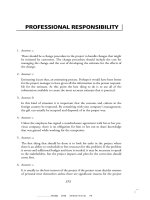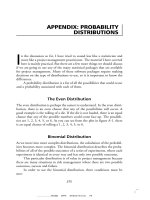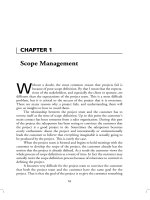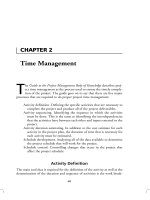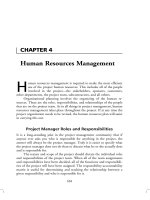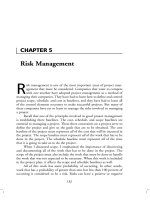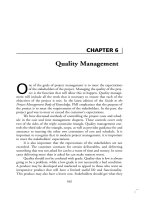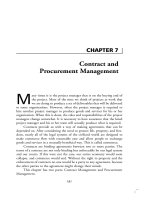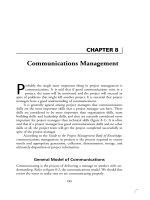Management Presentation Chapter 3
Bạn đang xem bản rút gọn của tài liệu. Xem và tải ngay bản đầy đủ của tài liệu tại đây (965.05 KB, 43 trang )
Organizational Goals
Purposes of Goals
Guidance and
unified direction
•
•
•
•
Promotion of
good planning
Source of
motivation
Evaluation
and control
Provide guidance and a unified direction for people in the
organization. (e.g. GE -> #1)
Have a strong effect on the quality of other aspects of
planning. (e.g. setting a financing goal)
Serve as a source of motivation for employees of the
organization. (e.g. each worker has a goal for how long it
should take to perform his or her job).
Provide an effective mechanism for evaluation and control
of the organization. (e.g. mid-year check)
Kinds of Organizational Goals
Setting Organizational Goals
By Level
By Area
By Time Frame
Mission statement
Strategic goals
Tactical goals
Operational goals
Operations
Marketing
Finance
Production
Long-term goals
Intermediate goals
Short-term goals
Explicit goals
Open-ended goals
FIGURE 3.1
The Planning Process
The planning process takes place within an environmental context. Managers must develop a complete and
thorough understanding of this context to determine the organization’s mission and to develop its strategic,
tactical, and operational goals and plans.
What Goals Do
• By Level
– Mission statement is a statement of the
organization’s fundamental purpose.
– Strategic goals, set by top management, address
broad competitive issues.
– Tactical goals, set by middle managers, that focus on
how to operationalize actions to strategic goals.
– Operational goals, set by lower-level managers,
focus on actions in support of tactical goals.
Kinds of Goals
• For Example, Starbucks
• Mission: To inspire and nurture the human spirit –
one person, one cup and one neighborhood at a
time.
• Strategic Goals: Increase its per-store profitability
by 25% over the next 5 years.
• Tactical Goals: Create tactical goals for the
company-owned vs. licensed stores in different
countries.
• Operational Goals: Boost the profitability of some
certain number of stores in the next 5 years
Kinds of Organizational Plans
– Strategic Plans are developed to achieve strategic
goals. It is set by the board of directors and top
management, generally address questions of scope,
resource deployment, competitive advantage, and
synergy.
– Tactical goals are developed to implement parts of a
strategic plan. Typically, tactical plans involve upper and
middle managers and have a shorter time frame than the
strategic plan.
– Operational goals focus on carrying out the tactical
plans to achieve operational goals. They are developed
by middle and lower-level managers and have a shortterm focus.
Planning Flow in Organizations
Strategic Plans
(upper management)
Tactical Plans
(middle management)
Operational Plans
(lower-level managers)
Time Frames for Planning
• The Time Dimension of Planning
– Planning must provide sufficient time to fulfill the managerial
commitments involved.
1
5
10
Long-range (strategic)
plans of 5 or more years
Intermediate-range
(tactical) plans of 1–5 years
Short-range (operational)
action and contingency
plans of 1 year or less
Years
The Nature of Strategic Management
• Strategy
– A comprehensive plan for accomplishing an
organization’s goals.
• Strategic Management
– The comprehensive and ongoing process of
formulating and implementing strategies to approach
business opportunities and challenges.
• Effective Strategies
– Promote a superior alignment between the
organization and its environment and the achievement
of its goals.
Basic Components of Strategy
Components of Strategy
Distinctive
Competence
Competitive
Scope
Resource
Deployment
The Components of Strategy
• Distinctive Competence
– Something an organization
does exceptionally well.
• Competency is anything a business does well.
• Core Competency is a competency of the business that is
essential to its overall performance and success
• Distinctive competency is any capability that distinguishes a
company from its competitors.
• Competitive Advantage: When a company possesses
distinctive competencies, it can transform these attributes
into a competitive advantage. Competitive advantage is
crucial for a company to be successful in the long term.
The Components of Strategy
• Scope
– Range of markets in which
an organization will compete.
• Hershey: Restricts its scope to food-related products.
– />
• Mars: Adopts a broader scope by competing in different
industries, including food products, pet food, pet hospital,
etc.
– />
• Resource Deployment
– How an organization will distribute its
resources in areas in which it competes.
Types of Strategic Alternatives
• Business-level Strategy
– The strategic alternatives that an organization chooses
from as it conducts business in a particular industry or a
particular market.
– Strategies developed for each industry or market.
• Corporate-level Strategy
– The strategic alternatives that an organization chooses
from as it manages its operations simultaneously across
several industries and several markets.
– An Overall strategy that helps define the mix of
industries and markets that are of interest to the firm
Organizational Structure and
Strategic Alternatives
Corporate-level strategy
Market A
Market B
Business-level strategy
Business-level strategy
Functional-level strategy
Functional-level strategy
Operations-level strategy
Operations-level strategy
The Relationships of Strategies
by Organizational Level
Corporate
strategy
Business
strategy
Functional
strategy
Formulation
Implementation
Decisions about which
markets to compete in
Competing in these markets
via existing operations,
mergers, acquisitions, new
ventures, divestitures
Formulation
Implementation
Decisions about how to
compete in each market
Carrying out the strategies
chosen for each business
Formulation
Implementation
Decisions about how to
address each function
within the organization
Carrying out the strategies
chosen for each function
The formulation stage determines what the strategy is, and the
implementation stage focuses on how the strategy is achieved.
3–16
Using SWOT To Formulate Strategy
The starting point
in formulating
strategy is usually
SWOT.
SWOT Analysis:
Strengths,
Weaknesses,
Opportunities,
and Threats
SWOT Analysis: Evaluating Strengths
• Organizational Strengths
– Skills and abilities enabling an organization
to conceive of and implement strategies.
• Distinctive Competencies
– Strengths possessed by only a small number of
competitors that are useful for competitive advantage
and superior performance.
• Competitive Advantage
– Results from a firm exploiting its unique competencies
to attain superior performance.
SWOT Analysis: Evaluating Weaknesses
• Organizational Weaknesses
– Insufficiencies of skills and capabilities that limit an
organization’s choice of strategic actions in support of
its mission.
• Weaknesses can be overcome by:
– Making investments to obtain the strengths needed.
– Modifying the organization’s mission so it can be
accomplished with the current workforce.
Evaluating an Organization’s
Opportunities and Threats
• Organizational Opportunities
– Areas in the organization’s environment that may
generate high performance.
• Organizational Threats
– Areas in the organization’s environment that make it
difficult for the organization to achieve high
performance.
SWOT
• Strengths
– What does the company do well?
– Is the company strong in its market?
– Does the company have a strong sense of purpose
and the culture to support the purpose?
• Weaknesses
– What does the company do poorly?
– What problems could be avoided?
– Does the company have serious financial liabilities?
SWOT
• Opportunities
– Are industry trends moving upward?
– Do new markets exist for the company’s products/ services?
– Are there new technologies that the company can exploit?
• Threats
– What are competitors doing well?
– What obstacles does the company face?
– Are there troubling changes in the company’s business
environment (technologies, laws, and regulations)?
SWOT Example
Formulating Business-Level Strategies
Porter’s Generic
Strategies
Differentiation
strategy
Overall cost
leadership
strategy
Focus
strategy
According to Michael Porter, organizations may
pursue a differentiation, overall cost leadership,
or focus strategy at the business level.
Porter’s Generic Strategies
• Differentiation Strategy
– Seeking to distinguish an organization from its
competitors through the quality of its products or
services.
• Overall Cost Leadership Strategy
– Attempting to gain competitive advantage by reducing
overall costs below the costs of competing firms.
• Focus Strategy
– Concentrating on a specific regional market, product
line, or group of buyers.
